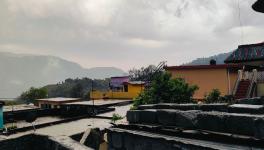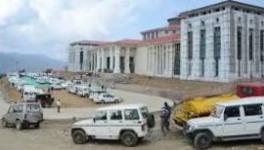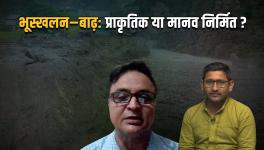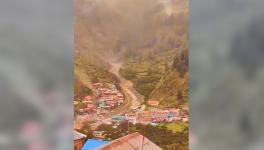SC-appointed Committee Directs Centre to Stop Work on Char Dham Road Network in Uttarakhand
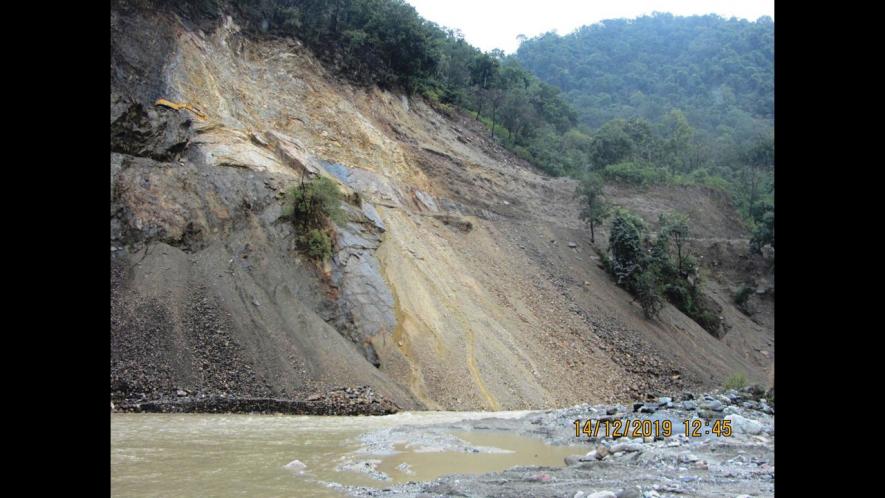
Hill cutting and muck dumping on one of the sites on Char Dham routes. Photo credit: Hemant Dhyani.
The Chairman of the High Powered Committee (HPC), which was formed to monitor the Char Dham Project (CDP) in Uttarakhand, has written to the project head at the Ministry of Road, Transport and Highways (MoRTH) to stay all the ongoing construction activities till the committee reviews it in context of the Supreme Court’s September 8 order.
The Char Dham Project, an all-weather road network, is supposed to connect the four holy shrines of Uttarakhand.
The Supreme Court on September 8 directed the Centre to abide by the MoRTH circular of 2018 stipulating intermediate road configuration with carriage way width up to 5.5 metre with two-lane formation.
Ravi Chopra, the HPC chairperson, has said the ongoing construction activities is in violation of the Supreme Court’s order as it has been proceeding with the old road width norms, which is 10 metres.
He said, “In my letter dated September 11 to secretary MoRTH, I have reminded MoRTH that no new hill cutting is to be done in the ongoing and proposed projects till the HPC has reviewed the rapid Environment Impact Assessment (EIA) report and issued specific directions thereafter.”
“However, I have received reports from the Helang-Badrinath sector, Rudraprayag sector, Tilwara (109) stretch, Kamand Uttarkashi etc. that road widening activities like tree felling, hill cutting, demolition of urban structures, and notification for land acquisition proceedings are still continuing,” he said, adding, “At this stage, it is most likely that these activities are being carried on as per old road width norms. Hence, these activities are in violation of the SC order and should be stayed till the HPC has reviewed your proposed work plan, issued directions so that unnecessary adverse impact on environment and social life could be avoided.”
VS Khaira, the project in-charge of CDP, told NewsClick, “The ongoing work where hills have been cut cannot be stopped immediately, as the chairperson of HPC has instructed. These slopes require to be stabilised. We are not undertaking any fresh activities”
Based on the field observations, the HPC members had earlier arrived at the conclusion that the dimension of road width is directly proportional to the ecological devastation. “The greater the road width requirement, the greater the required slope cutting, slope destabilization thereby, and following on its tracks - soil loss, green cover loss, tree felling, loss of topsoil, and loss of water source, the committee said.
Aggrieved by recurring landslides and road blockage caused due to sheer negligence exhibited by the contractors under CDP by way of alleged steep hill cutting, mindless tree felling, untreated slopes and indiscriminate muck dumping, a group of activists had moved the SC. The apex court then formed the HPC in August last year to monitor the project and Ravi Chopra was appointed its chairperson.
In his letter to Khaira, Chopra has also asked for submission of a comprehensive work plan in compliance with the Supreme Court’s direction to follow the 2018 MoRTH circular.
Regarding the preparation of the project’s work plan for consideration by the HPC, Chopra asked them to furnish details about various types of stretches such as where the formation width of 12 metre has been cut and 10 metre has been tarred; where 12 metre formation width has been cut but no tarring has been done; fresh stretches in ongoing projects where cutting has not been done; existing stretches in ongoing projects where the existing road is already double-lane and stretches where work projects are yet to begin.
The HPC chairman also sought submission of the full inventory of vulnerable slopes and muck dumps along the CDP routes. This inventory will be put in public domain.
He also sought a work plan for sustainable restoration of damaged slopes and authorised muck dump sites, beginning with a comprehensive vulnerability assessment of the failed slopes. “Generic and patchwork solutions are to be avoided as they quickly fail resulting into the loss of life and limb besides property damage or public funds. Proposals for restoration works are also to be put into the public domain,” he added in his letter.
With regard to the information sought by the HPC, Khaira said, “It will take us time to furnish all the information. However, we have provided details with regard to rapid EIA, vulnerable slopes and working plans for fresh projects as per the SC directives.”
While referring to the notification of land acquisition for the construction of toll plaza on the Yamunotri highway between Dharasu and Silkyara, the HPC chairman has also directed the CDP routes to be preferably toll free. Should toll taxes become essential, it must be free for vehicles registered in Uttarakhand. Having already utilised the natural resources of the residents of Uttarakhand, there is little justification for further charging them toll tax, he wrote.
Additionally, he also asked for details about the construction of all the toll plaza stations planned on the Char Dham route.
Costing a whopping Rs 12,000 crore, CDP is one of the largest road widening projects in the Himalayan belt in India. It was inaugurated by Prime Minister Narendra Modi in December 2016.
Get the latest reports & analysis with people's perspective on Protests, movements & deep analytical videos, discussions of the current affairs in your Telegram app. Subscribe to NewsClick's Telegram channel & get Real-Time updates on stories, as they get published on our website.














